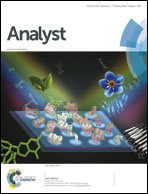Design, synthesis and characterization of a hexapeptide bio-inspired by acetylcholinesterase and its interaction with pesticide dichlorvos
Abstract
This paper describes the molecular modeling design, synthesis and characterization of a new bio-inspired hexapeptide of acetylcholinesterase enzyme and its interaction with the organophosphate pesticide dichlorvos monitored by UV-Vis spectroscopy and mass spectrometry. This strategy can contribute to the development of synthetic receptors to be coupled to biosensor transducers, avoiding the issues associated with proteins such as low stability under different pH and temperature conditions and high production cost. The resulting data of this work indicate a strong interaction between the pesticide dichlorvos and the hexapeptide (NH3+-Glu-His-Gly-Gly-Pro-Ser-COO−) with a binding constant of 4.10 × 105 M−1 and the formation of an adduct by covalent binding on the serine residue from the hexapeptide.


 Please wait while we load your content...
Please wait while we load your content...